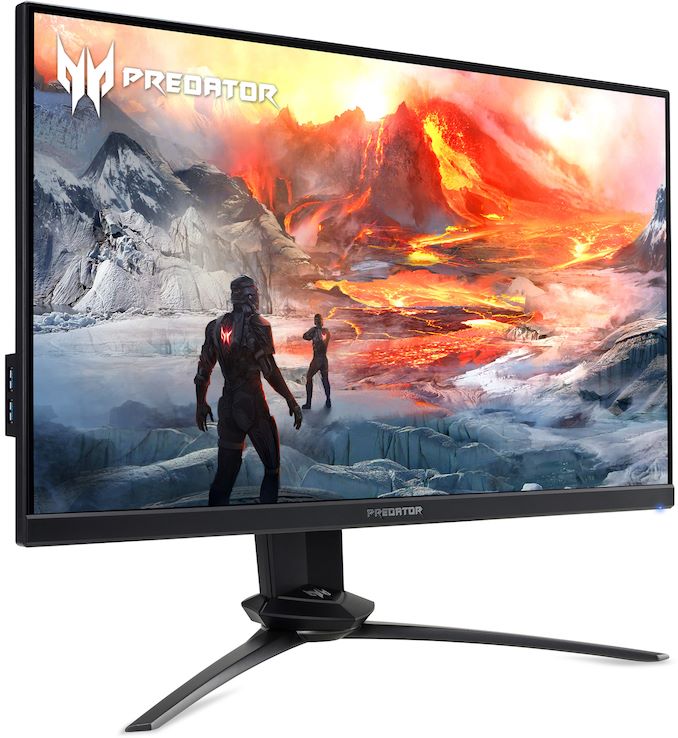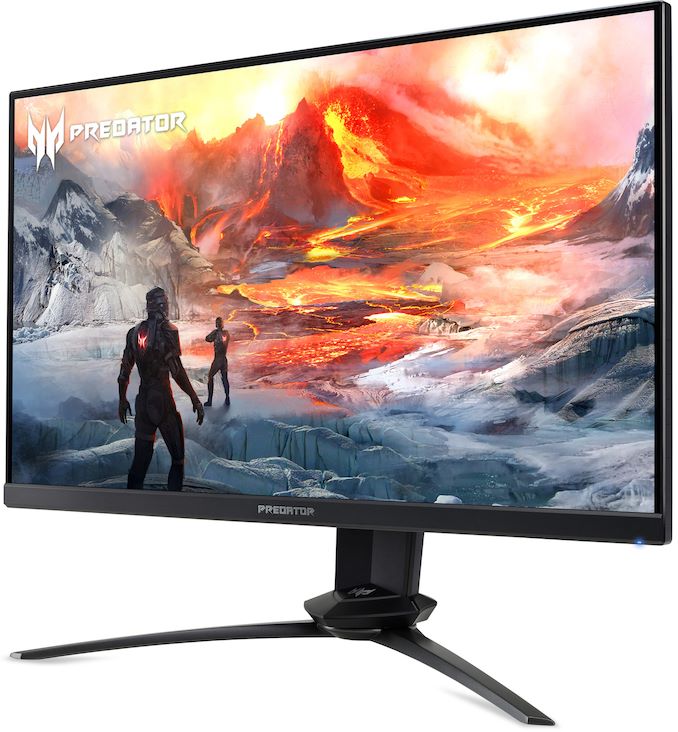Acer Launches Predator XN253QX Monitor with 240 Hz & 0.4 ms G2G Response Time
by Anton Shilov on August 14, 2019 10:00 AM EST
Acer has introduced its new Predator XN253QX display, which is aimed at professional gamers who are looking for top-tier response times. The Predator XN253QX has a maximum refresh rate of 240 Hz, features a response time of 0.4 ms, and support NVIDIA’s G-Sync variable refresh rate technology.
The Acer Predator XN253QX monitor is based on an 8-bit TN panel featuring a 1920x1080 resolution, 400 nits brightness, a 1000:1 contrast ratio, and so on. The key features of the panel are its maximum refresh rate of 240 Hz, a 3 ms native response time as well as a 0.4 ms gray-to-gray response time. Acer notes that the display uses its "Fast Liquid Crystal" technology, but does not really go into detail about what the technology is.
The latest gaming monitor from Acer also supports NVIDIA’s G-Sync variable refresh rate technology with a 30 – 240 Hz range (when operating over DisplayPort), which will certainly please demanding gamers looking for flexibility in their high refresh rate monitors. Like other displays for that market, the Predator XN253QX LCD also has numerous features for gamers, including aim point and dark boost. Last but not least, the display also has an adjustable stand, as well as VESA mounts.
When it comes to connectivity, the Predator XN253QX has a DisplayPort 1.2a as well as HDMI 1.4 connectors. As added bonuses, the LCD also has stereo speakers as well as a USB 3.0 hub.
| Acer's Predator Display with 240 Hz Refresh & 0.4 ms Response Time | ||
| The Predator XN253QX | ||
| Panel | 25-inch class TN | |
| Native Resolution | 1920 × 1080 | |
| Maximum Refresh Rate | 240 Hz | |
| Dynamic Refresh | Tech | NVIDIA G-Sync |
| Range | 30 - 240 Hz | |
| Brightness | 400 cd/m²* | |
| Contrast | 1000:1 | |
| Viewing Angles | 170°/160° horizontal/vertical | |
| Response Time | 0.4 ms GtG | |
| Pixel Pitch | ~0.28 mm² | |
| Pixel Density | ~90 PPI | |
| Color Gamut Support | sRGB (?) 72% NTSC |
|
| Inputs | 1×DP 1.2 1×HDMI 1.4 |
|
| Audio | 2×2 W speakers audio input audio output |
|
| VESA Mounts | 100 × 100 mm | |
| Warranty | 3 years | |
| Additional Information | ? | |
| Retail Price in the UK | £549 | |
| Note | *Not all specs of the LCD have been confirmed | |
Acer’s Predator XN253QX will ship in mid-September. In the UK, the product will cost £549, but the price will be different in other regions.
Related Reading:
- Acer Unveils KG1 Displays with Sub-1ms Response Time
- AOC’s Agon Monitors with 0.5ms Response Time & 240 Hz Refresh Now Available
Source: Acer












9 Comments
View All Comments
JoeyJoJo123 - Wednesday, August 14, 2019 - link
https://www.youtube.com/watch?v=Wah5_fY6fsEProbably uses the same 25" 240hz panel used in the Gigabyte KD25F. Hardware Unboxed's tests generally revealed that .5ms GtG was likely only a figure for best-case scenarios under the fastest overdrive mode (ie: introduces overshoot artifacts), and that under the optimal overdrive setting and across a range of different transitions, it's not really .5ms GtG. That being said, this panel is the fastest on the market, so regardless of the monitor-maker, if your goal is competitive PC games, then this new wave of 25" 240hz TN panels are the monitors to get.
close - Wednesday, August 14, 2019 - link
I'm not sure what "3 ms native response time" means but GtG response time is a giant steaming pile of marketing if there ever was one. Imagine if someone ever told you your car can accelerate from one speed to another in less than 1.4s. But it accelerates natively in 4.1s.It's a stupid and deceiving metric and one should NEVER take it at face value until someone actually measures and confirms what it means according to an agreed standard (like BtB). The monitor equivalent of 0-100-0Km/h.
And any self respecting tech journalist should call them out on this BS every time and say clearly that the particular measurement says nothing about actual monitor performance.
Beaver M. - Wednesday, August 14, 2019 - link
If they were that honest, they would also add the input lag to their product description. But they dont.There are several monitors out there that achieve sub-1 ms input lag, have been since at least 2012.
Yet you still see "gaming"monitors with input lag FAR FAR above that. 20 times as much is not rare. And yet reviewers still call an input lag of 5 to 15 ms good.
Santoval - Thursday, August 15, 2019 - link
It is similar to the static vs dynamic contrast ratio. Static contrast ratio is the true contrast ratio, the dynamic one is ... whatever each marketing team wants it to be. The GtG response time apparently is about the luminosity response rate - the time it takes each pixel to switch from one shade of grey to another, or from a brighter/darker color X to darker/brighter color X.Probably not the luminosity range from full black to full white, but from a certain dark shade of grey to a certain light shade of grey, which are of course whatever each manufacturer wants. So that's equivalent to the dynamic contrast ratio. It is practically useless, because it could only be accurately measured with a special "temporal photometer" or some similar device when the monitor was in black & white mode (so that the colors don't get in the way) and after the lowest and highest parts of the luminosity (darkest and brightest respectively) were clipped out.
"Native response time", in contrast, should take into account both the full luminosity range of the panel *and* the full color range (and color change rate) of the panel. I have no idea if the "3 ms" number they gave is valid, but assuming it is, it's the only useful response rate number of the panel, since this is what our eyes can see. 3 ms is a number 7.5 times larger than 0.4 ms. 3 ms might just be the true response rate, but 0.4 ms sounds much sexier, which is why I am quite certain Acer will bury that 3 ms number deep in the monitor's specs...
Opencg - Thursday, August 15, 2019 - link
The gtg is most likely to be a transition from dark grey to black. But on these new monitors it is most likely just a lie. A recent acer monitor advertized as 0.3ms gtg was measured by tft central and found to have 0.9ms as the best out of 30 possible transitions measured.The average reality is that these new sub ms monitors are about 25% better in terms of motion clarity vs yesterdays 240hz. Once again the advertizing is basically a lie.
imaheadcase - Wednesday, August 14, 2019 - link
Is this a joke right? No wonder no one is investing in better panels when they keep making this crap.. what incentive do they have..lolAlexvrb - Thursday, August 15, 2019 - link
You know of a faster panel? Not everybody cares about resolution or color gamut. There's a monitor for every market, if you're not the target demographic go look somewhere else. Seriously. You don't see me bitching every time they release a professional panel that has terrible response time - it's not aimed at me.Dragonstongue - Wednesday, August 14, 2019 - link
1000% agree with last few folks, was going to say pretty similar.Peddle all the crap you want, but when you see it not being sold or folks end up complaining
"Y'all have yourselves to blame"
We already have to deal with plenty enough marketing BS spins "to make the sale"
be different, and list actual response time (true input lag best case type thing)
Not convoluted metrics "everyone else is doing it, so it must be good enough"
No, no it is NOT good enough, response time, input lag, total shift between contrast / flicker and all that lovely stuff, at least have readily available free of charge.
There is also the flat title of 240Hz long arse number instead of 1080p / 240Hz HDMI v2+ / DP 1.3+ / DVI / (other ports as on the product in question)
many consumers are not "idiots" but treating them like they are, or not error checking instruction manuals is making the companies in question "fools and liars"
we deserve better than such treatment.
GreenReaper - Wednesday, August 14, 2019 - link
> Color Gamut: sRGB (?)They probably just said that by itself because 72% NTSC is about 100% sRGB